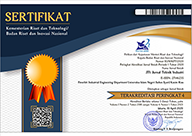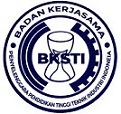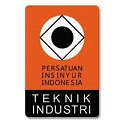Integrating DMAIC Six Sigma for Systematic Defect Analysis and Quality Improvement in Manufacturing (Case Study: Rattan Craft Industries)
Abstract
This study focuses on a rattan-based manufacturing unit producing Base Plant Stand products, where a significant number of defects—2,305 units out of 9,000—were identified, resulting in a current sigma level of 3.14. By employing qualitative and quantitative research approaches, the study aims to identify root causes of product defects and propose process improvements to minimize their occurrence. Using the DMAIC framework of Six Sigma, the most frequent defect types were mold (27.9%), imprecision (22.7%), loose tie (20.9%), and pinhole (15.88%). Key contributing factors included excessive humidity, limited production space, insect infestation, and insufficient operator skills. Based on field research and literature, the proposed improvements include covering products with tarpaulins during rainy conditions, expanding work-in-progress (WIP) space, providing operator training, and developing clear standard operating procedures (SOPs). These recommendations aim to enhance product quality and increase the sigma level through systematic, continuous improvement. The findings are a practical reference for similar small-scale manufacturing operations seeking to optimize their production processes through quality management tools.
Keywords: Six Sigma, DMAIC, 5W+1H, Product Defects, Rattan
Full Text:
PDFReferences
F.Ahmad, “Six Sigma Dmaic Sebagai Metode Pengendalian Kualitas Produk Kursi Pada Ukm,” Jisi Um, vol. 6, no. 1, p. 7, 2019.
F. Choirunnisa and T.Nova, “Implementasi Lean Six Sigma dalam Upaya Mengurangi Produk Cacat pada Bagian New Nabire Chair Kursi Rotan,” EDUSAINTEK, vol. 4, 2020.
L. I. K. Nafiah and L.Herdiman, “Penerapan Six Sigma sebagai Metode Pengendalian dan Perbaikan Kualitas Produk Kursi Rotan,” in Seminar Dan Konferensi Nasional IDEC 2023, 2023, pp. 1–9.
N.Nurhayani, S. R.Putri, andA.Darmawan, “Analisis Pengendalian Kualitas Produk Outsole Sepatu Casual menggunakan Metode Six Sigma DMAIC dan Kaizen 6S,” J. Tek. Ind. J. Has. Penelit. dan Karya Ilm. Dalam Bid. Tek. Ind., vol. 9, no. 1, pp. 248–258, 2023.
G. Improta, “Agile six sigma in healthcare: Case study at Santobono Pediatric Hospital,” Int. J. Environ. Res. Public Health, vol. 17, no. 3, 2020, doi: 10.3390/ijerph17031052.
R. C.Lestari, K. F.Handayani, G. G.Firmansah, andM.Fauzi, “Upaya Meminimalisasi Cacat Produk Dengan Implementasi Metode Lean Six Sigmas: Studi Kasus Perusahaan PT XYZ,” J. Bayesian J. Ilm. Stat. dan Ekon., vol. 2, no. 1, pp. 82–92, 2022.
I.Doyer, “As easy as OEE: enabling productivity improvement in schools by using overall equipment effectiveness as a framework for classroom data analysis,” Int. J. Lean Six Sigma, vol. 14, no. 5, pp. 1055–1074, 2023, doi: 10.1108/IJLSS-03-2022-0057.
M. V. Sunder, “Lean Six Sigma in higher education institutions,” Int. J. Qual. Serv. Sci., vol. 8, no. 2, pp. 159–178, 2016, doi: 10.1108/IJQSS-04-2015-0043.
N. O. Erdil, “Embedding sustainability in lean six sigma efforts,” J. Clean. Prod., vol. 198, pp. 520–529, 2018, doi: 10.1016/j.jclepro.2018.07.048.
V. Gupta, “Monitoring quality goals through lean Six-Sigma ensures competitiveness,” Int. J. Product. Perform. Manag., vol. 61, no. 2, pp. 194–203, 2012, doi: 10.1108/17410401211194680.
J. Antony, “Application of Six Sigma DMAIC methodology in a transactional environment,” Int. J. Qual. Reliable. Manag., vol. 29, no. 1, pp. 31–53, 2012, doi: 10.1108/02656711211190864.
M. Yusuf and E.Supriyadi, “Minimasi Penurunan Defect Pada Produk Meble Berbasis Prolypropylene Untuk Meningkatkan Kualitas Study Kasus: PT. Polymindo Permata,” Ekobisman J. Ekon. Bisnis Manaj., vol. 4, no. 3, pp. 244–255, 2020.
A. F.Sanny, M.Mustafid, andA.Hoyyi, “Implementasi metode lean six sigma sebagai upaya meminimalisasi cacat produk kemasan cup air mineral 240 ml (studi kasus perusahaan air minum),” J. Gaussian, vol. 4, no. 2, pp. 227–236, 2015.
L. L.Salomon, A.Ahmad, andN. D.Limanjaya, “Strategi Peningkatan Mutu Part Bening Menggunakan Pendekatan Metode Six Sigma (Studi Kasus: Department Injection Di PT. KG),” J. Ilm. Tek. Ind, vol. 3, no. 3, pp. 156–165, 2017.
R.Oktaviani, H.Rachman, M. R.Zulfikar, andM.Fauzi, “Pengendalian Kualitas Produk Sachet Minuman Serbuk Menggunakan Metode Six Sigma Dmaic,” J. Ilm. Tek. Dan Manaj. Ind., vol. 2, no. 1, pp. 122–130, 2022.
D. Caesaron and T.Tandianto, “Penerapan Metode Six Sigma Dengan Pendekatan DMAIC Pada Proses Handling Painted Body BMW X3 (Studi Kasus: PT. Tjahja Sakti Motor),” Penelit. dan Apl. Sist. dan Tek. Ind.., vol. 9, no. 3, p. 182846, 2015.
M. Assarlind, “Multi-faceted views on a Lean Six Sigma application,” Int. J. Qual. Reliab. Manag., vol. 29, no. 1, pp. 21–30, 2012, doi: 10.1108/02656711211190855.
V. S.M, “A conceptual Lean Six Sigma framework for quality excellence in higher education institutions,” Int. J. Qual. Reliable. Manag., vol. 35, no. 4, pp. 857–874, 2018, doi: 10.1108/IJQRM-01-2017-0002.
H. Tannady and K.Filbert, “Pengendalian Persediaan dengan Menggunakan Metode Economic Oreder Quantity dan Silver Meal Algorithm (Studi Kasus PT SAI),” J. Tek. dan Ilmu Komput., 2018.
G.Yadav, “A fuzzy AHP approach to prioritize the barriers of integrated Lean Six Sigma,” Int. J. Qual. Reliable. Manag., vol. 34, no. 8, pp. 1167–1185, 2017, doi: 10.1108/IJQRM-01-2016-0010.
I.Alhuraish, “A comparative exploration of lean manufacturing and six sigma in terms of their critical success factors,” J. Clean. Prod., vol. 164, pp. 325–337, 2017, doi: 10.1016/j.jclepro.2017.06.146.
P. S. Parmar, “Evaluating Sustainable Lean Six Sigma enablers using fuzzy DEMATEL: A case of an Indian manufacturing organization,” J. Clean. Prod., vol. 265, 2020, doi: 10.1016/j.jclepro.2020.121802.
M. Rachmawati and J.Purnama, “Analisis Pengendalian Kualitas Guna Meminimalkan Jumlah Cacat Pada Produk Nice Burlwood Console Table,” Ind. Inov. J. Tek. Ind., vol. 14, no. 1, pp. 116–123, 2024.
N. Chugani, “Investigating the green impact of Lean, Six Sigma and Lean Six Sigma: A systematic literature review,” International Journal of Lean Six Sigma, vol. 8, no. 1, pp. 7–32, 2017. doi: 10.1108/IJLSS-11-2015-0043.
M. G. Aboelmaged, “Six Sigma quality: A structured review and implications for future research,” Int. J. Qual. Reliable. Manag., vol. 27, no. 3, pp. 269–318, 2010, doi: 10.1108/02656711011023294.
R. Cima, “Use of lean and six sigma methodology to improve operating room efficiency in a high-volume tertiary-care academic medical center,” J. Am. Coll. Surg., vol. 213, no. 1, pp. 83–92, 2011, doi: 10.1016/j.jamcollsurg.2011.02.009.
A.Irwanto, D.Arifin, andM. M.Arifin, “Peningkatan Kualitas Produk Gearbox Dengan Pendekatan Dmaic Six Sigma Pada Pt. X, Y, Z,” J. Kalibr. Karya Lintas Ilmu Bid. Rekayasa Arsitektur, Sipil, Ind., vol. 3, no. 1, pp. 1–17, 2020.
DOI: http://dx.doi.org/10.24014/jti.v11i1.35323
Refbacks
- There are currently no refbacks.
Copyright (c) 2025 Adinda Nurlaela

This work is licensed under a Creative Commons Attribution-NonCommercial-ShareAlike 4.0 International License.
Jurnal Teknik Industri
P-ISSN 2460-898X | E-ISSN 2714-6235
Published by:
Industrial Engineering Department
Universitas Islam Negeri Sultan Syarif Kasim Riau, Indonesia
Office Address:
H.R. Soebrantas KM 15.5, Tampan, Pekanbaru, Riau, Indonesia 28293
email: jti.fst@uin-suska.ac.id
Indexed by:
JTI : Jurnal Teknik Industri under a Creative Commons Attribution-NonCommercial-ShareAlike 4.0 International License.

















